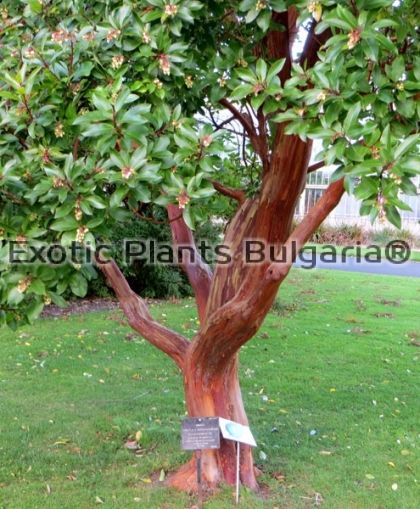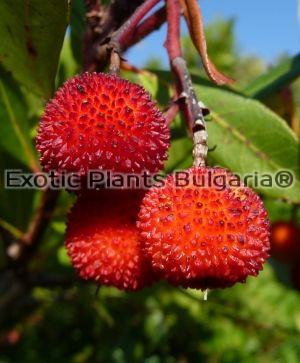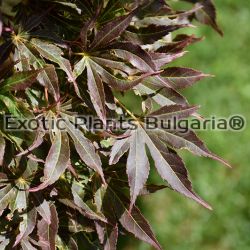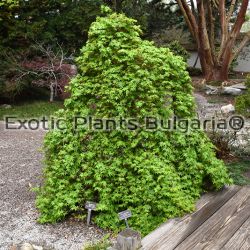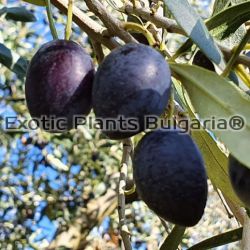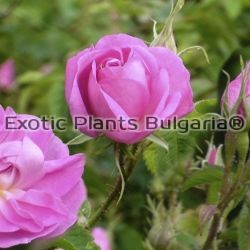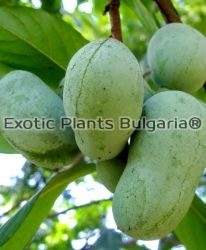Вечнозелено дърво с цветове подобни на камбанка и приличащи на цветовете на момината сълза. Цветът е кремаво бял но понякога са и розови. Плодовете узряват през есента , обикновенно през октомври, ноември и са с екзотичен вкус A. × andrachnoides развива много красива корона и е най бързорастящия вид от себеподобните , наричани ягодови дървета. Кората му е червена до канелено кафява, изключително атрактивна в напреднала възраст. Този хибрид е наричан още с името - " мексиканско ягодово дърво" студоустойчив е за по голяма част от територията на България, като изключим някои котловини, където не е желателно да се засажда. Предпочита добре дренирана почва и пълно слънце.
A. unedo grows widely in Greece along with a more tender and spring-flowering species called the Grecian strawberry tree (Arbutus andrachne). This is a very attractive tree with a trunk and stems that share the same snuff-brown hue and papery texture of cinnamon sticks. Unfortunately, it is too tender for British gardens but can survive in very sheltered positions once mature.
Thankfully, nature has provided us with a hardier hybrid, Arbutus x andrachnoides. This wide-spreading yet small tree is sometimes called the red-barked strawberry tree. The quality of clone can differ and misnaming in the nursery trade is rife, so it is worth purchasing from a good nursery - particularly as the textured bark takes time to develop. A good form is a winter delight.
However, if you desire end-of-the-year flowers to lift the November gloom, opt for A. unedo instead. Although the roughly fissured, dull brown bark is not particularly exciting, it is still an exceptional winter specimen and produces fruit more readily.
Several distinct forms of A. unedo have been selected; 'Rubra' is a pink-belled form, 'Atlantic' a free-flowering compact form which fruits early, plus a dense bushy form called 'Elfin King'. However, these lack the simple elegance of the species, to my eye.
There is also an interesting hybrid of unknown provenance (arguably between A. x andrachnoides and A. canariensis) called 'Marina'. This spectacular plant has much larger panicles of rose pink flowers, beautiful peeling bark, bigger and shinier leaves, and larger fruits. Plants in pots have withstood temperatures as low as -15C at Madrona Nursery in Kent but it is considered to be less tolerant of lime and chalk than other varieties.
Despite their beauty, strawberry trees are not as widely grown now as they were 100 years ago. Instead we nurture the olive, which limps rather sadly through winter in many areas. Yet these evergreen beauties have much more to offer and they fit into British gardens well. Perhaps warmer winters will encourage more of you to plant them.
Growing tips
All three species grow wild in Greece, often on the edge of olive groves close to the sea, and the hardier pair make excellent specimens for temperate coastal gardens in Britain, wherever the soil is well-drained.
The heather-like flowers indicate that strawberry trees are ericaceous. Often members of this family require acid soil, but these are lime-tolerant and chalk friendly. However, a lovely American species with a wonderful red-brown and pistachio-green trunk, A. menziesii, is an acid lover. Commonly called the madrona, this forms a large tree.
Strawberry trees are best planted young because they resent disturbance. Sun and warmth are essential, so choose a sheltered position in well-drained soil away from frost pockets. Never allow waterlogging. Plant in spring where possible, to allow the plant several months to acclimatise before winter sets in. Be prepared to cosset your young plant through its first few winters by covering it with a fleece liner in extremely cold weather.
As it matures, it will become hardier. Pruning prevents fruit setting as the "strawberries" are formed from the previous year's flowers. Early summer is the time to cut back any long stems. Seed can be sown into sand but the resulting plants will vary. Better to take semi-ripe cuttings in late summer. These will root in a heated propagator.



